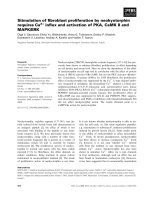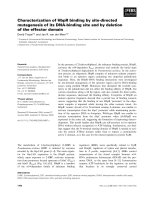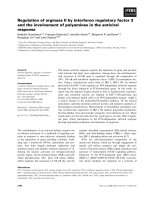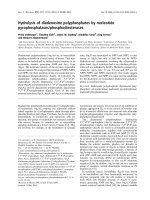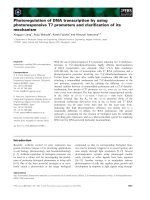báo cáo khoa học: "Immobilization of different biomolecules by atomic force microscopy" pptx
Bạn đang xem bản rút gọn của tài liệu. Xem và tải ngay bản đầy đủ của tài liệu tại đây (1.03 MB, 7 trang )
RESEA R C H Open Access
Immobilization of different biomolecules by
atomic force microscopy
Michael Breitenstein
1,2*
, Ralph Hölzel
1
, Frank F Bier
1,2
Abstract
Background: Micrometer resolution placement and immobilization of probe molecules is an important step in the
preparation of biochips and a wide range of lab-on-chip systems. Most known methods for such a deposition of
several different substances are costly and only suitable for a limited number of probes. In this article we present a
flexible procedure for simultaneous spatially controlled immobilization of functional biomolecules by molecular ink
lithography.
Results: For the bottom-up fabrication of surface bound nanostructures a universal method is presented that
allows the immobilization of different types of biomolecules with micrometer resolution. A supporting surface is
biotinylated and streptavidin molecules are deposited with an AFM (atomic force microscope) tip at distinct
positions. Subsequent incubation with a biotinylated molecule species leads to binding only at these positions.
After washing streptavidin is deposited a second time with the same AFM tip and then a second biotinylated
molecule species is coupled by incubation. This procedure can be repeated several times. Here we show how to
immobilize different types of biomolecules in an arbitrary arrangement whereas most comm on methods can
deposit only one type of molecules. The presented method works on transparent as well as on opaque substrates.
The spatial resolution is better than 400 nm and is limited only by the AFM’s positional accuracy after repeated z-
cycles since all steps are performed in situ without moving the support ing surface. The principle is demonstrated
by hybridization to different immobilized DNA oligomers and was validated by fluorescence microscopy.
Conclusions: The immobilization of different types of biomolecules in high-density microarrays is a challenging
task for biotechnology. The method presented here not only allows for the deposition of DNA at submicrometer
resolution but also for proteins and other molecules of biological relevance that can be coupled to biotin.
Background
Bottom-up fabrication of defined nanostructures on
solid surfaces requires immobilization of different
addressable biomolecules as anchors. Nanometer scaled
deposition of minute sample volumes was f irst intro-
duced by Mirkin and co-workers [1,2] and was realized
by dip-pen nanolithography [3-5] where the tip of an
atom ic force microscope (AFM) is used to deposi t reac-
tive compounds directly on a surface.
However, it is difficult to use such lithographic meth-
ods for a fast and easy deposition of different biological
compounds on the same carrier. So far no techniques
were reported capable of deposing more than two kinds
of biomolecules with a single tip. In addition, these bio-
molecules have to match the needs of the used spotting
method. In the group of Klenerman [6,7] a method for
the controlled deposition of biomolecules using a scan-
ning nanopipette was developed. They deposited bio mo-
lecules by electrophoretic flow applying a local voltage
between the nanopipette and the surrounding medium
that covers the functionalized surface. An alternative
method with high sp atial resolution is based on synthesis
on the chip: Fodor and co-workers [8] developed a
method to produce microarrays by repetitively uncover-
ing photo-labile protecting groups on an activated silicon
wafer with UV irradiation through a mask. Deprotection
of the photolabile groups leads to coupling of the modi-
fied compounds. This method was commercialized by
Affymetrix, who developed microarray feature si zes of
10 × 10 μm
2
but is limited to oligonucleotides and
* Correspondence:
1
Fraunhofer Institute for Biomedical Engineering, Department of
Nanobiotechnology and Nanomedicine, Am Mühlenberg 13, 14476 Potsdam,
Germany
Breitenstein et al. Journal of Nanobiotechnology 2010, 8:10
/>© 2010 Breitenstein et al; licensee BioMed Cent ral Ltd. This is an Open Access article distributed under the terms of the Creative
Commons Attribution License (http://creat ivecommons.org/licenses/by/2.0), which permits unrestricted use, distribution, and
reproduction in any medium, provided the original work is properly cited.
peptides. However their length is restricted due to
incomplete reactions [ 9]. For higher quality and more
versatility of biomolecule species, the deposition of pre-
synthesized molecules is advantageous. Here we present
a novel, universal technique that allows immobilizing dif-
ferent types of biomolecules in a wel l defined, high reso -
lution pattern by using only one single AFM-tip.
Chemical and fluidic properties of the molecules that
have to be immobilized by this method may differ and do
not have to match, as it is the case with other methods.
This approach is a first step towards generating individu-
ally patterned nanostructures fixed on surfaces and
allows the construction of DNA anchored structures.
The method presented is a microcontact printing, still
it is highly flexible and pattern independent. The p roto-
cols and methods that are established in microcontact
printing, e.g. [10] , have recently been shown to be
applicable to the preparation of microscopically small
features [11] and, hence, could be combined with
our approach for immobilizing several different
biomolecules.
This work is aimed at the development of a universal
method for the production of micrometer scaled arra ys
with several different immobilized biomolecules. For
scaling down feature size and for greater flexibility an
atomic force microscope (AFM) was used. The AFM-
tip is utilized like a pen and allows small volume
deposition of reactive compounds. A crucial prerequi-
site for the immobilization of different biomolecules is
to avoid any cross contaminations. This can be
achieved by either cleaning or replacing the tip. How-
ever, replacing would result in a decreased accuracy
due to long distance-moving of the tip, whereas clean-
ing might precipitate cross contaminations and,
furthermore, would result in decreased accuracy
because of the additional movement. To solve this pro-
blem, neutravidin is used as a natural, highly reactive
linker for biotinylated biomolecules and is deposited
by a single AFM-tip. This results in two significant
advantages: Besides an improved accuracy of spot posi-
tions, optimization and adaptation steps for deposition
are reduced to a minimum, since only one chemical
compound, neutravidin, is to be deposited.
Results and Discussion
We employ common AFM-tips without further modifica-
tion. They are well suited to apply glycerol based ink con-
taining neutravidin on a homogeneously biotinylated glass
surface with high precision. Because of the transparent
and non-conducting glass, the array is accessible for
further analysis, e.g. optical microscopy or conductance
measurements. Neutravidin is used because it offers speci-
fic binding sites for biotin. It captures up to four biotin
molecules and forms one of the strongest non-covalent
bonds with an unbinding force of up to 250 pN [12] giving
high stability. The generated spots, where the neutravidin
is bound to the covalently immobilized biotin, remain
reactive for at least one further biotin molecule due to its
four binding sites. Here it is used as a natural linker where
biotinylated biomolecules can co uple. Biotinylation is
commonly used and commercially available for most
kinds of biomolecules. Therefore, DNA, proteins, nano-
beadsandmanyothermoleculessuchasdyescanbe
immobilized. The technique is performed sequentially and
a further spotting step with neutravidin follows when the
neutravidin array has been incubated with the first biotiny-
lated molecule species. The procedure is concluded by a
further incubation with the next type of biotinylated bio-
molecule. This cycle of spotting and biomolecule binding
can be repeated several times. In Figure 1 the whole proce-
dure is illustrated being completed by complementar y
DNA hybridization. Time consuming incubation and cou-
pling steps can be avoided due to the fast binding process.
The whole spotting can be carried out under ambient tem-
peratur e and humidity condi tions reduc ing execut ional
complexity.
To test the procedure it was applied for the preparation
of an array of biotinylated dyes. First a glass slide was gas-
phase silanized with aminopropyltriethoxysilane (APTES)
to provide the surface with reactive aminogroups that can
couple with NHS-biotin for the following homogeneous
biotinylation. The biotinylation was carried out over night
in phosphate buffer. Then the s lides were washed with
water and dried with nitrogen. Like this, they can be
stored at room temperature for several weeks. In addition
to neutravidin and water, the ink contained glycerol to
delay evaporation. Spotting started with loading the AFM-
tip with ink, utilizing a micro capillary. The AFM-tip was
immersed into the droplet that formed at the end of the
capillary. A micromanipulator helped to move the ink
reservoir. Once the tip was loaded with i nk, the script-
based spotting protocol was started by approaching and
contacting the surface in succession. For each spot the
neutrav idin loaded tip remained in contact with the sur-
face for four seconds. Due to the fast binding between
neutravidin and surface-bound biotin, a five minutes incu-
bation time after spotting the complete array was suffi-
cient. Accordingly, the target substance that had to be
immobilized - here demonstrated by a biotinylated fluores-
cent dye DY-547 in carbonate buffer - was also incubated
for five minutes to bi nd to the spotted neutravidin. Incu-
bation was performed under the same environmental con-
ditionsasspotting.Figure2presentsafluorescence
micrograph of an AFM-spotted 9 × 9-array on a glass
slide. The grid measures 9 μm between spot centers with
1.5 μm diameter.
Immobilization of more than one substance is
achieved by dividing the array into two sub-arrays which
Breitenstein et al. Journal of Nanobiotechnology 2010, 8:10
/>Page 2 of 7
Figure 1 Illustration of the spotting process. The first spot is gene rated by addressing the spotted neutravidin with biotinylated
oligonucleotides. All following spots can be created by repeated spotting and addressing without replacing the surface. Here, the whole cycle is
completed after two passes. By hybridization with complementary ssDNA which is fluorescently labeled the array can be visualized.
Breitenstein et al. Journal of Nanobiotechnology 2010, 8:10
/>Page 3 of 7
are generated sequentially. The first neutravidin array
was spotted, followed by immediate incubation of the
biotinylated fluorescent dye DY-547. Washing of
unbound dye was performed with PBS and subsequently
ultrapure water without physically moving the specimen.
After that the second neutravidin array was g enerated
exactly within the same region to complete the final
array. This was achieved without replacing or moving
the surface where we s potted on so that an alignment
was unnecessary. At this point the array comprised of a
fluorescent dye coupled to neutravidin and new, unad-
dressed, neutravidin. The latter then were addressed by
the second biotinylated dye through incubation with
DY-647-Biotin. After washing again wi th PBS and ultra-
pure water the array was visualized by fluorescence
microscopy. The successively immobilized dyes were
excited separately: Figure 3a shows DY -547-Biotin
addr essed spots (excited with 545 nm), Figure 3b shows
DY-647-Biotin addressed spots (excited with 620 nm).
The merged image of the array is shown in Figure 3c.
For the construction of defined structures on the
nanometer scale nucleic acids are very promising com-
pounds. Their ability to form structures on a molecular
level by self-asse mbly [13,14] is the basis for new tech-
nical applications. Immobilization of DNA-molecules
was tested as follows. To prevent unspecific binding of
DNA, the targeted surface was blocked. Strategies
using biological (e.g. BSA from AppliChem GmbH,
64291 Dortmund, Germany) and synthetic (e.g. Roti-
Block from Carl Roth GmbH & Co. KG, Karlsruhe,
Germany) blocking methods were tested as well as
casein (Sigma Chemical CO, MO 63178 USA) blocking
which turned out to work best (data not shown). In
respect to cross-hybridization and hybridization effi-
ciency Niemeyer and colleagues [15,16] optimized sev-
eral 22 base pair sequences. Three of their published
DNA sequences were chosen. The single stranded 5′-
biotinylated forms were immobilized in the same way
as described above. In the first immobilization s tep the
biotinylated strand (RcF6) was incubated, followed by
thesecond(LcF5)andfinallythethirdone(RcF2)to
generate a three component array. After washing resi-
dualDNA,thearraywasreadyforhybridizingwitha
mixture of three oligonucleotides being complementary
to each of the DNA sequences and having been labeled
by three different fluorescent dyes. According to the
Figure 2 Fluorescence micrograph.Spotted9×9arrayona
biotinylated glass surface. After spotting neutravidin, the array was
incubated with the biotinylated dye DY-547 and finally washed with
water. The distance between each spot centre is 9 μm. The
systematic reduction of spot size is owed to depletion of the tip-
loading.
Figure 3 Two component array. Fluorescence photomic rograph of a sequentially spotted, two component array. a) DY-547-channel,
b) DY-647-channel, c) merged image of a) and b) with each dye color coded differently.
Breitenstein et al. Journal of Nanobiotechnology 2010, 8:10
/>Page 4 of 7
self-assembling capability of DNA the labeled DNA
strands hybridized to the immobilized oligonucleotides
(see Figure 4). It is evident that the first incubation led
toacompleteoccupationofallneutravidinspots.
Cross talk between the three channels of the array is
showninFigure5:Cy5-channel:2.5%forCy3and
0.6% for Atto-495; Cy3-channel: 0.5% for Cy5 and 4.8%
for Atto-495; Atto-495-channel: 3.5% for Cy5 and 2.0%
for Cy3. To compare the resulting signals w ith respect
to cross talk between the filter-cube combinations,
fluorescence signals of individual one-substance arrays
without any cross contamination were tested. The
resulting signals were found to be in the same range as
thosemeasuredinthearrayinFigure4(datanot
shown). Consequently cross contaminations are negli-
gible with this method.
Conclusions
A novel approach has been presented for the high reso-
lution immobilization of multiple biomolecules on a
solid glass support and within the same array. The
unique feature o f the meth od is that optimization of the
spotting protocol can be reduced to just one spotting
substance, regardless of what kind of biotinylated mix-
ture of biomolecules is t o be arranged. Two completely
different species of molecules have been used to demon-
strate the sequence of working steps: biotinylated fluor-
escence dyes and single stranded DNA. In addition to
the flexibility of the whole process, the possibility to
treat the surface prior to each spotting step simplifies
the whole procedure considerably. The unaffected bio-
chemical activity of the immobilized molecules was
shown by hybridization of a mixture of fluorescently
labeled complementary oligonucleotides. In general, the
results pave the way for creating surface bound and well
addressed nanostructures that are based on functional
biomolecules.
In subsequent steps the spots may be used to immobi-
lize a variety of arbitary molecular species in a single
array. In contrast to gold-thiol chemistry, the glass
Figure 4 Three component array. Fluorescence micrograph of t hree hybridized Cy3, Cy5 and Atto495 functionalized oligonucleotides after
sequential spotting of neutravidin. The three complementary oligonucleotides are represented by red, green and blue spots, respectively.
a) Cy3-channel, b) Cy5-channel, c) Atto-495-channel, d) merged image.
Breitenstein et al. Journal of Nanobiotechnology 2010, 8:10
/>Page 5 of 7
remains accessible for all types of optical microscopy.
The whole immobilization procedure can be performed
on transparent as well as opaque surfaces. The solid
glass support can be employe d for many applications
where a non-conductive, transparent surface is needed.
The procedure is also interesting for other structuring
methods like micro-contact printing. We expect that
existing nanolithography methods can be upgraded
using the presented method.
All experiments have been carried out with nanolitho-
graphic tools, such as standard AFM-tips and script-
based execution. It would also be possible to modify this
general procedure for microcontact printing methods to
fulfill the needs of industrial mass production. Further
investigations will aim to reducefeaturesizetothesub
micrometer range to enable fabrication of DNA-based
nano-structures.
Methods
Silanization and biotinylation
Glass slides (Menzel Gläser, Menzel GmbH & Co. KG,
38116 Braunschweig, Germany) were cleaned with
ultrasound in acetone for 15 minutes and again in
ethanol (acetone an d ethanol we re obtained from Carl
Roth GmbH & Co. KG, Karlsruhe, Germany). After
rinsing with ultrapure water, the slides were put into
NaOH (10 M) for 1 minute and washed thoroughly
with water. Drying was carried out in a centrifuge
(Varifuge 3.0R, Heraeus) for 1 minute at 2 g. In vapor
phase at 120°C the silanization with 3-Aminopropyl-
triethoxysilane (Fluka Chemie GmbH, 89552 Stein-
heim, Germany) was executed in a seale d beaker and
finished after 60 minutes. Silanization was tested by
contact angle measurements by the sessile-drop tan-
gent method - contact angle system from Dataphysics
OCA30. For biotinylation, Sulfo-NHS-Biotin (20 mg)
(Thermo Scientific, IL 61101 USA) was dissolved in
DMSO (1 mL) (Carl Roth GmbH & Co. KG) because
of its low stability and moisture-sensitivity. The DMSO
solved Sulfo-NHS-Biotin can be stored at -20°C with
desiccant. Sulfo-NHS-Biotin (10 mL) solution was
added to Na
2
HPO
4
(100mM,21mL),NaCl(150mM)
buffer at pH 7.4. Incubation of 5 silanized glass slides
took place for 3 hours at room temperature. Slides
were washed with PBS a nd rinsed with water. Blocking
was carried out by incubating the glass slides in a
freshly preparated, 0.1% (w/v) solution of blocking
reagent CA from Applichem in 100 mM Tris-Cl. For
cleaning, slides were washed three times for 5 minutes
in Tris-Cl and finally rinsed with ultrapure water.
NaOH, Na
2
HPO
4
, NaCl, PBS and blocking reagent CA
were obtained from AppliChem GmbH, 64291 Dort-
mund, Germany.
Array preparation
Addressing the spotted neutravidin (Thermo Scientific,
IL 61101 USA) was accomplished by incubation of the
biotinylated substance that had to be immobilized. Bioti-
nylated dyes (Dyomics GmbH, 67745 Jena, Germany) as
well as the biotinylated oligonucleotides (Biomers.net
GmbH, 89077 Ulm, Germany) were diluted in carbonate
buffer pH 9.0 to a final concentration of 0.5 mM. Incu-
bation time for binding was 5 minutes and was stopped
by washing with 1× PBS-buffer and ultrapure water. Oli-
gonucleotides were treated with ad ditional hybridization
of fluorescently marked ssDNA. Hybridization was
Figure 5 Cross contamination. Measured fluorescence signals of individual spots in the Cy3, Cy5 and Atto-495-channel.
Breitenstein et al. Journal of Nanobiotechnology 2010, 8:10
/>Page 6 of 7
carried out in the dark for 30 minutes at 37°C and 80%
relative humidity. Sequences of the oligonucleotides
(Niemeyer et al.): LcF5: 5’ -cttatcgcttt atgacc
ggacc-3’ (5’:Biotin);RcF6:5’ -caatgaaacactag
gcgaggac-3’ (5’ :Biotin)andRcF2:5’ -gtc
ggttctaagaaaatggcgg-3’ (5’ : Biotin). The three
fragments were diluted in TE-buffer (50 mM Tris-Cl,
100 mM NaCl, AppliChem GmbH) to a final concentra-
tion of 1 mM. Washing was carried out with PBS-buffer
and stringent washing with ultrapure water.
Spotting
The atomic force microscope CP-II from Veeco (Santa
Barbara CA, 93117 USA) and AFM-tips from NanoSen-
sors (NanoAndMore Gm bH, 35578 Wetzlar, Germany):
DT-CONTR (force constant: 0.2 N/m; resonance fre-
quency: 13 kHz) was used. Movement of the AFM-tip
and execution were controlled by the diNanolithography
Software V.1.8. Approaching the biotinylated glass slide
was achieved in contact mode with 3.4 mN contact
force. The tip remained in contact for 4 seconds and
changed to the next spotting positions by retraction. Ink
was supplied by a hypodermic needle of Popper & Sons,
Inc. (N.Y. 11040 USA).
Microscopy
Fluorescence microscopy was carried out with an
upright epifluorescence micro scope Olympus A BX51
(objective: UPlanFL N; 40×/0.75). Fluorescence detection
was accomplished with the following filter-cube combi-
nations: Cy3 and DY-547 detect ion: excitation filter (Ex)
BP 545/25, dichromatic mirror (Dm) 565, emission filter
(Em) LP 605/70; for Cy5 and DY-647 detection: Ex BP
620/60, Dm 660, Em BP 70 0/75; and for Atto495 detec-
tion: Ex BP 460 - 495, Dm 505, Em LP 510 - 550. For
illumination a mercury arc lamp (100 W, OSRAM
GmbH, 81543 München, Germany) was used. Image
acquisition was carried out with a CCD camera from
Finger Lakes Instrumentatio n (FLI, New York 14485
USA; CM10-ZME; 6.8 μm pixel pitch; 2184 × 1472 pix-
els) in combination with FLIGrab Software V1.10. Image
editing was realized with ImageJ V1.42q.
Acknowledgements
We thank A. Christmann for technical assistance with the atomic force
microscope and M. Schellhase for performing tests and her expertise in
general spotting technology. We gratefully acknowledge critical commentary
and reviewing the manuscript by A. Peukert. We like to thank the European
Commission for the support of this work (contract no. STRP13775, project
Nucan).
Author details
1
Fraunhofer Institute for Biomedical Engineering, Department of
Nanobiotechnology and Nanomedicine, Am Mühlenberg 13, 14476 Potsdam,
Germany.
2
University of Potsdam, Institute for Biochemistry and Biology, Karl-
Liebknecht-Str. 24-25, 14476 Potsdam, Germany.
Authors’ contributions
MB performed the experiments and designed most of them. RH and FB
conceived of the study and participated in its design and coordination. The
authors participated in the evaluation and interpretation of the experiments.
MB prepared the first draft of the manuscript and all authors contributed to
its finalization.
Competing interests
The authors declare that they have no competing interests.
Received: 4 January 2010 Accepted: 17 May 2010
Published: 17 May 2010
References
1. Piner RD, Zhu J, Xu F, Hong S, Mirkin CA: Dip-Pen Nanolithography.
Science 1999, 283 :661-663.
2. Demers LM, Ginger DS, Park SJ, Li Z, Chung SW, Mirkin CA: Direct
Patterning of Modifed Oligonucleotides on Metals and Insulators by
Dip-Pen Nanolithography. Science 2002, 296:1836-1838.
3. Ginger DS, Zhang H, Mirkin CA: Zur Entwicklung der Dip-Pen-
Nanolithographie. Angew Chem 2004, 116:30-46.
4. Krämer S, Fuierer RR, Gorman CB: Scanning Probe Lithography Using Self-
Assembled Monolayers. Chem Rev 2003, 103:4367-4418.
5. Basnar B, Willner I: Dip-Pen-Nanolithographic Patterning of Metallic,
Semiconductor, and Metal Oxide Nanostructures on Surfaces. Small 2009,
5(1):28-44.
6. Ying L, Bruckbauer A, Zhou D, Gorelik J, Schevchuk AI, Lab M, Korchev YE,
Klenerman D: The scanned nanopipette: a new tool for high resolution
bioimaging and controlled deposition of biomolecules. Nano Letters
2006, 6:252-257.
7. Rodolfa KT, Bruckbauer A, Zhou D, Korchev YE, Klenerman D: Two-
Component Graded Deposition of Biomolecules with a Double-Barreled
Nanopipette. Angew Chem int Ed 2005, 44:6854-6859.
8. Fodor SPA, Read JL, Pirrung MC, Stryer MC, Lu AT, Solas D: Light-directed,
spatially addressable parallel chemical synthesis. Science 1991,
251:767-773.
9. Bier FF, von Nickisch-Rosenegk M, Ehrentreich-Förster E, Reiss E, Hengel J,
Strehlow R, Andresen D: DNA microarrays. Adv Biochem Eng Biotechnol
2008, 109:433-453.
10. Thibault C, Berre VL, Casimirius S, Trévisiol E, François J, Vieu C: Direct
microcontact printing of oligonucleotides for biochip applications.
Current Opinion in Chemical Biology 2000, 4:609-618.
11. Geissler M, Roy E, Deneault JS, Arbour M, Diaz-Quijada GA, Nantel A,
Veres T: Stretching the Stamp: A Flexible Approach to the Fabrication of
Miniaturized DNA Arrays. Small 2009, 10:1-5.
12. Goddard J, Hotchkiss J: Polymer surface modification for the attachment
of bioactive compounds. Prog Polym Sci 2007, 32:698-725.
13. Hölzel R, Gajovic-Eichelmann N, Bier FF: Oriented and vectorial
immobilization of linear M13 dsDNA between interdigitated electrodes -
towards single molecule DNA nanostructures. Biosensors & Bioelectronics
2003, 18:555-564.
14. Niemeyer CM: Self-assembled nanostructures based on DNA: towards
the development of nanobiotechnology. Current Opinion in Chemical
Biology 2000, 4:609-618.
15. Feldkamp U, Wacker R, Schroeder H, Banzhaf W, Niemeyer CM: Microarray-
Based in vitro Evaluation of DNA Oligomer Libraries Designed in silico.
ChemPhysChem 2004, 4:367-372.
16. Feldkamp U, Schroeder H, Niemeyer CM: Design and Evaluation of Single-
Stranded DNA Carrier Molecules for DNA-Directed Assembly. Journal of
Biomolecular Structure and Dynamics 2006, 23:367-372.
doi:10.1186/1477-3155-8-10
Cite this article as: Breitenstein et al.: Immobilization of different
biomolecules by atomic force microscopy. Journal of Nanobiotechnology
2010 8:10.
Breitenstein et al. Journal of Nanobiotechnology 2010, 8:10
/>Page 7 of 7





